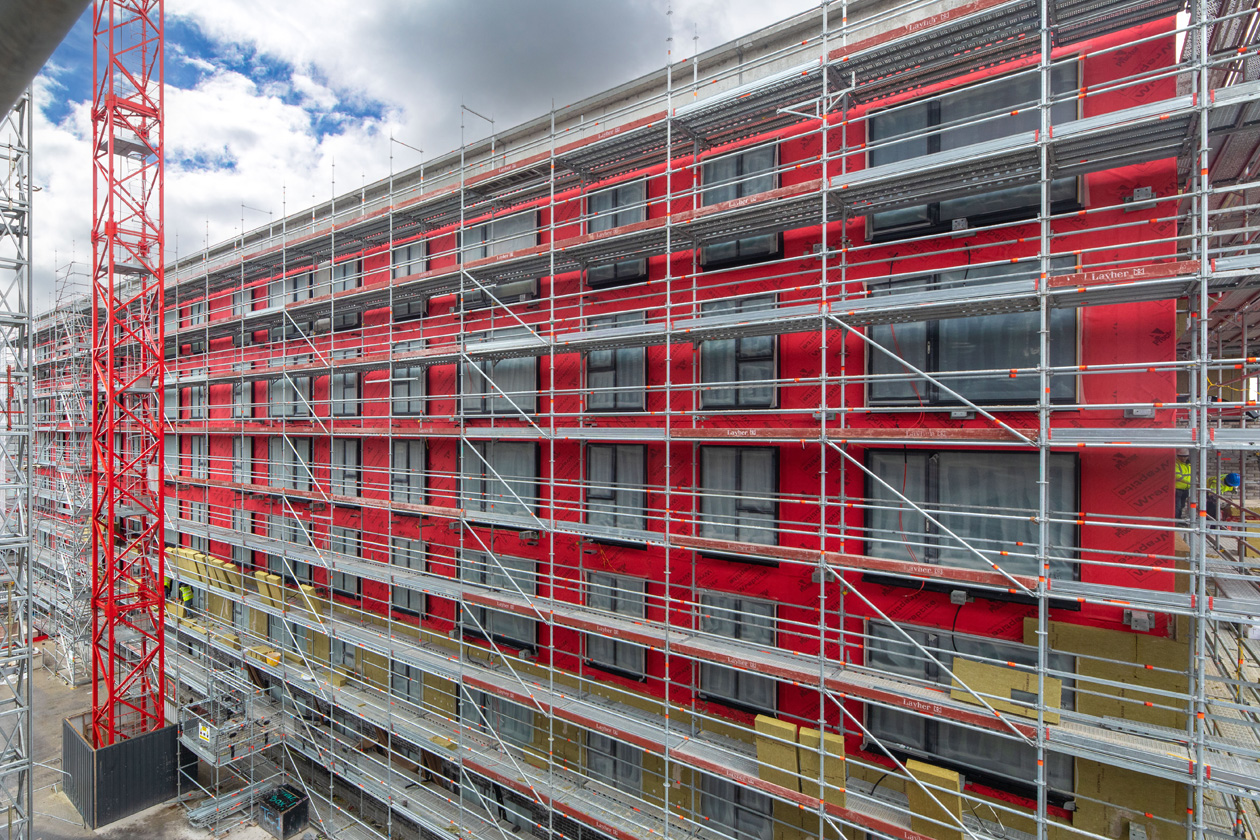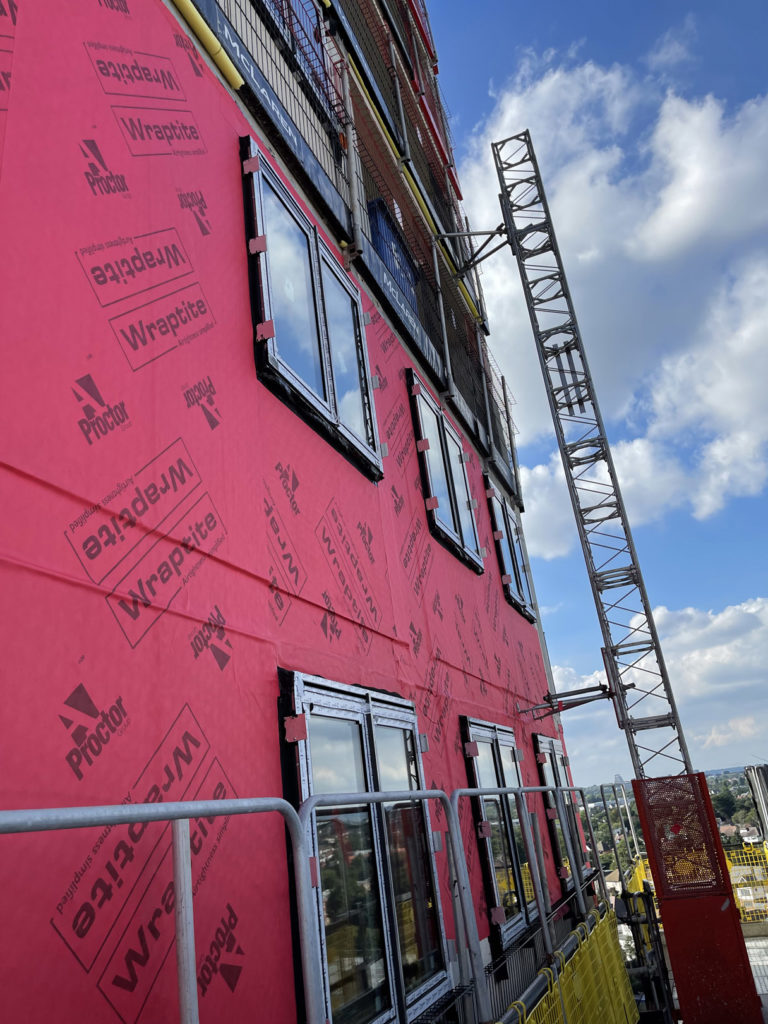A. Proctor Group discusses how the installation of vapour permeable air barriers can improve airtightness in education and healthcare buildings.
The importance and need for improving airtightness within public buildings such as schools, colleges, hospitals, and healthcare facilities is critical. The drivers for airtightness go beyond compliance with current Building Regulations, emphasised further by the massive increases in energy costs and the need to maintain healthy buildings. Effective design must address the balance between airtightness and managing the moisture in buildings, thereby placing the wellbeing of occupants as paramount.
The latest version of ‘Conservation of fuel and power: Approved Document L’ acknowledges the importance of getting airtightness right, explicitly mentioning that “when carrying out work in new dwellings, care should be taken to reduce unwanted heat loss through infiltration.” For example, highlighting the challenges of potential penetration of the air barrier as a result of internal building services and structural penetrations. The use of an external airtight barrier such as Wraptite from the A. Proctor Group is specifically designed to overcome the risk of damage to the traditional internal air barrier approach that can occur with internal service works.
The Wraptite system is the only self-adhering vapour permeable air barrier certified by the BBA. It combines the critical properties of vapour permeability and airtightness in one self-adhering membrane. This approach saves on both the labour and material costs associated with achieving the energy efficiency demands in buildings.

Air leakage through cracks, gaps, holes, and improperly sealed elements such as doors and windows can cause a significant reduction in the performance of even thermally insulated envelopes, in some cases reducing their effectiveness by up to 70%. In addition, unmanaged or uncontrolled airflow can act as a carrier for moist air, drawing it in from the outside or pushing it from the inside outwards into walls, ceilings, and roofs. The impact of this uncontrolled moist air movement can have a detrimental effect on the life of the building and the health of its occupants.
The high vapour permeability of the Wraptite air barrier allows the substrate beneath to dry quickly and moisture vapour to escape and reduces the likelihood of mould, mildew, condensation, timber distortion and metal corrosion.
Airtightness in education buildings
A vital element of the design and construction is to maximise energy efficiency. Controlling spiralling energy costs is particularly key in educational facilities such as schools and colleges. The high-performance airtightness qualities of the Wraptite air barrier system have been installed at a state-of-the-art development at St Dunstan’s College — a co-educational independent school in Catford, London. The project comprises a new Junior School, STEM building and Sixth Form Hub.
Designed by Bond Bryan Architects, phase one includes a new junior school with specialist facilities for art, music and performance, and phase two includes the construction of the STEM Centre and Sixth Form Hub. Including this airtightness barrier within the facade will ensure “as-designed” performance, narrowing the gap between asdesigned
and actual energy performance and reducing the likelihood of potential failures to meet required airtightness levels.

Airtightness in healthcare buildings
An example of the effectiveness of the external air barrier system is providing an efficient airtightness solution at two new-build extensions to the Connolly Hospital in Dublin. The project consisted of two phases, a new laboratory building in phase one, with a brand-new accident & emergency facility constructed in phase two.
Designed by architects MCA Dublin, award-winning drylining contractors McLaughlin Taylor of Donegal installed the Wraptite System as an external air barrier and alternative to a traditional standard breather membrane. The use of conventional membranes would have required mechanical fixing and added to the installation time. As an alternative, the
Wraptite self-adhesive membrane was applied externally, quickly, and easily to the external steel frame in continuous pieces.
Gio Fusco of McLaughlin Taylor commented: “The application of the self-adhesive Wraptite System was quick and easy to apply in a single application, with no requirement to return for additional fixings. We used Wraptite for both phases, and the air permeability test results were consistently excellent with both buildings achieving a rating of close
to or just below 2m3/hm2.”
The system is applied externally quickly and efficiently as part of the rainscreen system, is compliant with Part B regulation changes and has BBA approval for unrestricted use in relevant buildings over 11m/18m.
The self-adhesive membrane fully bonds directly to the substrate, requiring no mechanical attachment and little seals or tapes to suppress air leakage around junctions or penetrations. Internal air barriers can be complex and costly to install due to accommodating building services such as electrical, lighting, heating, and drainage systems. Positioning an air barrier outside the structural frame simplifies the process of maintaining the integrity of the envelope, with fewer building services and structural penetrations to be sealed.
The successful design of effective airtightness within public buildings such as schools, colleges, hospitals and healthcare facilities must be part of a wider holistic system approach. Thus, the best practice is one that balances energy efficiency, heat loss, and managing moisture without compromising the integrity of the building envelope or the wellbeing of the occupants.










